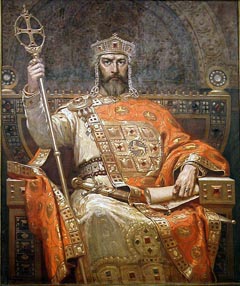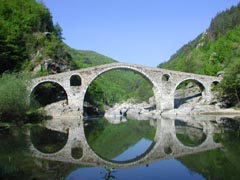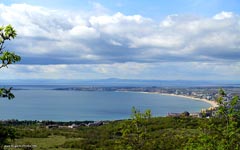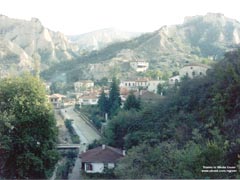by Assen Nikoloff
The ‘Bulgarian Horizon’ team is organizing a trip to Bulgaria in June 2008 - weeks 2 & 3. For information call Iskra Balchev at 602-617-8971.
Before the trip we are pleased to introduce you to the Bulgarian history as descriibed in “Bulgarian Folklore’’ - the first book in English by Assen Nikoloff.
Iskra Balchev
Publisher of “Bulgarian Horizon”
The author Assen Nicoloff {1905-], born in Bulgaria, spent the first twenty-one years of his life in his native country, and after coming to the United States he completed his college and university [Northwestern] education and then returned to Bulgaria where he taught history and geography at the American College of Sofia during the thirties.
ORIGIN OF THE BULGARIAN NATION
The Bulgarian nation evolved from the amalgamation of Slavs and Bulgars, both of whom came to the Balkan Peninsula from territories north of Danube.
THE SLAVS
Slavic crossings of the Danube and penetration into Balkan lands of Eastern Roman Empire was a slow process. Some of the first Slav migrants are said to have settled on Roman territory as COLONI who cultivated the land of rich farmers. Others were recruited as mercenaries for the Roman army. At the end of the fifth century large masses of armed Slavs began their frequent attacks south of the Danube. By the middle of the seventh century the Slavicization of the peninsula was an accomplished fact.
The patriarchal family, known as ZADRUGA, was at the basis of social organization among the Slavs. Community property was a characteristic feature of the ZADRUGA. Several ZADRUGA formed a clan. Related clans, claiming a common ancestor, formed a tribe. A military leader, known as VOIVODA, VLADICA OR GOSPODAR, was chosen from the richest and most powerful clan to lead the tribe in time of war. According to Byzantine historians, the Slavs were not united people. Lack of unity among the primitive Slavs, was due to the broken terrain of their original homeland. Slavs occupied small homestead within small villages. During the sixth century Slavs lived in scattered huts which they build along rivers, lakes and swamps, or on wooded land. Slavic fare came primary from agriculture, stock raising and hunting. Wheat was boiled and then dried for later use. Wine was unknown to the Slavs until they came into contact with Greeks and Romans on the Danube and the Black Sea. Clothing: The earliest garments were made of the fur and skins of wild animals. Later sheep skins figured prominently in the clothing of Slavs. Family life: Polygamy was known to the proto-Slavs. Christianity discouraged polygamy and later monogamy became the only legal form of marriage. Writing: Slavs did not develop the art of writing until the second half of the ninth century. Up to that time, they had used lines and notches in counting and calculating. Religion of the proto-Slavs is not well understood. They appear to have been animist who believed that all natural elements have a soul. They believed in a future life.
The Bulgars
The bulgars where known to the Byzantines as early as 482. Who were the Bulgars and when did they come? Racially they were of Turkic origin and they came from the steps of central Asia. Where they lived as early as the second century (The original home of the Bulgars is still a matter of speculation among historians. According to the adherents of the Turkic theory the Bulgars first live close to the Altai Mountains, along the Irtish River and the town of Kobdo in Western Mongolia. The “Great Bulgaria”, a union of Bulgarian tribes headed by Kubrat, occupied a territory north of the Cuba river, the Sea of Azov and the Black sea. After Kubrats death (c.550) the “Great Bulgaria” was destroyed. Asparukh, one of the Kubrats sons, let his horde to the Danube delta and settled in Southern Bassarabia. Eventually he found the Bulkan Bulgaria which was recognized by the Byzantine Emperor in 681. MAKING A LIVING. The proto-Bulgarians practice agriculture and the raising of livestock centuries before they founded Bulgaria of the Balkans. After settling in the Caucasus, Bulgar farmers added viticulture and fruitgrowing. FOOD. Beans, lentils, peas, etc. figured prominently Bulgar diet. Bulgar women baked bread, made rolls and pastry, cooked meat and vegetables. Horse meat was their favorite dish. Mare’s milk was another food relished by the Bulgars; they processed it and made yogurt, cheese and buttermilk. Beer and Boza (made from millet) where the staple beverages of the Bulgars. While on Caucasus they learned to make wine. INDUSTRY AND TRADES. Home industry occupied all Bulgar women. They spun wool, flax and hemp; they were good weavers and produce burlap, cloth, rugs, etc. The men worked in various trades and crafts. They were blacksmiths, carpenters, masons, potters, tanners, etc. Another trade the Bulgars demonstrated their skill was the building industry. CLOTHING AND HYGIENE. Bulgar clothing was practical and attractive. Both men and women wore baggy trousers. Men wore leather boots and light skull-caps. Proto-Bulgarians were particularly careful about bodily cleanliness. Reported cases about Bulgar men and women bathing in a river. THE FAMILY. The Bulgars were polygamous. Nevertheless, marriage depended on the ability of a man to pay for a wife in gold, silver, oxen, horses, or other valuables. Women left there faces unveiled. Adultery was a serious crime and was severely punished. Each family was part of a clan. (Aspurukh the first ruler of Bulkan Bulgaria was of the Dulo clan.) At the head of a clan were a number of notables called Boili [Boyars], were well-to-do people who commanded considerable influence with the Khan. WRITING AND CALENDAR. Whether the Bulgars had an alphabet of there own is not known. Of special interest is the Bulgar calendar. It was devised on the basis of a lunar year. RELIGION. The Bulgars believed in a single supreme being known as Tengri a word that was a synonym for sky. Tengri was believe to direct all human affairs, and his will determined everyone’s fate. Thus to protect them self from harm or avert the ills wrought by evil spirits. Many Bulgars wore amulets. Taking an oath was of great significance to the Bulgars. Once and oath was considered binding for the rest of one’s life. Bulgars also believed in everlasting retribution. They felt quite certain that Tengri would pay everyone according to his good or bad acts and behavior. The dead were interred or cremated. When a notable dies, servants be buried with him. Religion play an important part of the individual lives of the Bulgars and also served as the foundation for their whole social structure. Kubrat the founder of “Great Bulgaria” was converted to Christianity but found hardly any followers. The Bulgars on the Volga persisted in their paganism as late as the tenth century when they accepted Mohammedanism; by contrast Boris’ Bulgaria in the Balkans embraced Christianity in the ninth century.
THE FIRST BULGARIAN KINGDOM. Khan Asparuh (644-701) and his Bulgars founded the first Bulgarian kingdom South of the Danube in the Northeastern part of the Balkan Peninsula and the Byzantine Emperor recognized it in 681. In the course of time the Bulgars helped by local Slavic tribes, pushed South of the Balkan Mountains and turned Bulgaria ino a powerful European country in the Middle Ages. Being a minority the Bulgars were eventually assimilated by the Slavs whose vernacular has been the official language of the country since 893. Now there are fewer that twenty Bulgar words in the Bulgarian language. The Orthodox Christianity as the official religion helped to unite the Bulgarians into a nation with Slavic language and culture. As time went on Slavic beliefs, customs and traditions swept the country and the proto-Bulgarian language and culture receded until the vernacular of the Bulgars was no longer used in Bulgaria South of the Danube. Khan Boris (852-889) demonstrated his support of Slavic culture after he introduced Christianity in Bulgaria in 865. He dropped the Bulgar title khan and called himself Knyaz, a Slavic title of nobility meaning prince. Boris’ reforms proved most beneficial to the country. During the reign of his son Simeon (893-927) the Bulgarian literature reached its golden age and his country was looked upon as the cradle of Slavic civilization. Preslav, the capital of Bulgaria, became the center of Slavic civilization at the end of the ninth century and Ohrid developed into the western center of Slav-Bulgarian culture as a result of Saint Clement’s activities in Macedonia where he was sent by Simeon‘s father, Prince Boris, in 886 or thereabout. The Byzantine Empire was greatly alarmed by Bulgaria’s rise and waited for an opportunity to strike a mortal blow to her northwestern neighbor. In 1014 Basil II, known to history as the Bulgar Slayer, defeated Samuel and four years later, in 1018, put an end to the First Bulgarian Empire (681-1018) in the Balkans. For 169 years (1018- 1187) Bulgaria was part of the Byzantine Empire.
THE SECOND BULGARIAN KINGDOM (1187-1393) had its happy days during the reign of Asenides. Kaloyan (1197-1207) was victorious against both the Byzantines and the Latin Crusaders under the Emperor Baldwin I, whom he captured and imprisoned in Turnavo, the capital city of the Second Bulgarian Empire, where he died on April 4, 1205. Under Ivan-Asen II (1218-1241) the country reached the zenith of its power. Later, anxiety hardship and much suffering followed and were most characteristic during the Tataric invasions. Bulgaria’s independence came to an end when the Osman Turks captured Turnovo in 1393 and conquered the Kingdom of Vidin in 1396; Bulgaria was a part of the Ottoman Empire for almost five hundred years.
To be continued...

Simeon I the Great ruled over Bulgaria from 893 to 927.
The First Bulgarian Kingdom, considered to be Bulgaria’s “Golden Age,” emerged under his rule.
During this time, Bulgarian art and literature flourished.



